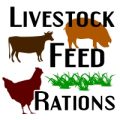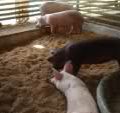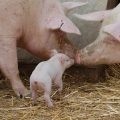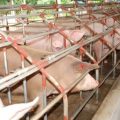Although demand for pork in many areas is high, the rising cost of production discourages many small farmers from attempting to raise swine on a small scale. The use of commercial feeds is one of the main reasons for high production costs. Purchased feeds can constitute 60-80% of total expenses. Once an animal is sold, the amount of return received, after paying the feed bill, is often too low to purchase another animal and sustain the cycle of production. Therefore, for farmers with little capital to invest, an alternative mode of production must be advocated. This alternative includes the utilization of low-cost materials and feeds available within the farm. Of particular importance is the potential to reduce feed costs.

BREEDS AND BREEDING:
Upgraded cross-breed animals are recommended.
FEEDS AND FEEDING:
1. Low-cost Feeds
Commercial feeds, while complete and usually available, are costly, thus driving up the cost of production for a swine project. However, a variety of non-conventional or traditional foodstuffs can be utilized to provide low-cost feeds to swine.
Below is a list of common on-farm resources which can be used as carbohydrate and protein sources and several ration formulas (with Crude Protein percentage) using some of the following feedstuffs:
| Carbohydrate Sources | Protein Sources (% Crude Protein) | ||
| Coconut oil meal (sepal) | 3 | Brewer’s spent grain (15.4) | 2 |
| Rice middlings | 1 or 4 | Copra meal (19.42) | 2 |
| Rice bran | 2 | Cowpea (33.89) | 4 |
| Banana trunks | 3 | Fish meal (53.44) | 2 |
| Sweet potato (leaves, vine end tuber) | 2 | Jackbean (25.75) | 4 |
| Cassava ([eaves end tuber) | 2 | Pigeon pea (20.46) | 4 |
| Taro (leaves, stem and tuber) | 1 or 2 | Mung bean (22.66) | 4 |
| Kangkong | 1 | Peanut oil meal (43.65) | 2 |
| Ulasiman | 2 | African snail (45.91) | 1 |
| Banana (peers end rice fruit) | 2 | Soybean meal (soya) (43.70) | 2 |
| Banana (raw fruit) | 1 | Rice bean (tapilan) (17.42) | 2 |
| Papaya (green) | 1 | Velvet bean (24.02) | 4 |
| Papaya (ripe) | 2 | Hyacinth bean (3.6) | 1 |
| Muskmelon | 2 | Leucaena leaves (17.52) | 2 |
| Jackfruit | 1 | ||
| Pineapple | 2 | ||
| Elephant yam (pongapong) | 1 | ||
| Yam bean (singkamas) | 2 | ||
| Ubi peelings | 1 | ||
| Leafy vegetables | 1 or 2 | ||
| Water lily | 1 |
1 — Needs cooking.
2 — Can be given fresh or as is.
3 — Should be mixed with rice bran or commercial feeds.
4 — Needs soaking.
LOW-COST SWINE RATIONS
| Ration 1 | Parts by Wt. |
| Rice bran | 60 kg |
| Yellow corn | 10 |
| Coconut (bagasse) | 10 |
| Leucaena leaf meal | 5 |
| Rice middlings | 5 |
| ——— | |
| 100 kg | |
| Crude Protein | 12.881% |
| Ration 2 | Parts by Wt. |
| Rice bran | 80 kg |
| Gabi tuber/Cassava | 20 |
| Japanese/Golden Snail | 10 |
| Ground yellow corn | 10 |
| Leucaena leaf meal | 10 |
| ——— | |
| 100 kg | |
| Crude Protein | 14.91% |
| Ration 3 | Parts by Wt. |
| Rice bran | 80 kg |
| Leucaena leaf meal | 15 |
| Rice middlings | 5 |
| ———– | |
| 100 kg | |
| Crude Protein | 14.9175% |
| Ration 4 | Parts by Wt. |
| Rice bran | 60 kg |
| Swamp cabbage leaves | 30 |
| Yellow corn | 5 |
| Coconut bagasse | 5 |
| ——— | |
| 100 kg | |
| Crude Protein | 9.965% |
| Ration 5 | Parts by Wt. |
| Rice bran | 60 kg |
| Banana trunks (chopped finely) | 30 |
| Leucaena leaf meal | 10 |
| ———- | |
| 100 kg | |
| Crude Protein | 10.591% |
| Ration 6 | Parts by Wt. |
| Dry camote | 57 kg |
| Rice bran | 30 |
| Copra meal | 4 |
| Fish meal | 5 |
| Soybean oil meal | 5 |
| ———- | |
| 100 kg | |
| Crude Protein | 10.6% |
| Ration 7 | Parts by Wt. |
| Cassava or sweet potato | 25 kg |
| Rice bran | 50 |
| Copra meal | 25 |
| ———– | |
| 1 00 kg | |
| Crude Protein | 11.45% |
2. Proper Feeding
a. Leftover food scraps from the house should be cooked to kill germs and remove toxin present in the foodstuff.
b. Unconsumed feeds in the troughs should be discarded before giving new feed to the animals.
3. How to Prepare Feeds for Swine
a. Chop all ingredients into small pieces.
b. Boil hard ingredients first (i.e., pongapong, green papaya, water lily, etc.).
c. When soft, add other ingredients (i.e., kangkong, leftover food, etc.).
d. Cook until done.
e. Cool.
f. Add a pinch of salt before feeding to the animals. These cooked feeds should be mixed – with rice bran when fed to the animals.
4. Alternative Feeding Management for a Fattener
a. During the first 2 months, feed piglets with commercial feeds (if the necessary ingredients to make a homemade, nutritious feeds are not available) to promote and boost growth.
b. In the second month, gradually substitute commercial starter ration with grower ration and begin slowly incorporating cooked supplemental feeds into the diet.
c. In the third month, one quarter of the ration can be replaced with supplemental, low-cost feeds previously listed.
d. At the fattening stage (4-6 months), one-half or more of the ration can be supplemental, lowcost feeds.
HEALTH MANAGEMENT:
1. Animals should be purchased from a reliable source in order to insure their hearth. Newly acquired animals should be isolated and observed for at least 2 weeks to determine their health status before introducing them into the pen area with other animals.
2. A regular schedule of vaccination should be followed to protect animals against swine diseases common in the area (i.e., hog cholera, etc.).
3. Animals should be regularly dewormed as needed or as local conditions dictate.
4. Improved sanitation ensures improved animal health:
a. Maintain clean pens.
b. Animals should be regularly bathed, especially during hot weather.
c. Excreta should be properly disposed, preferably composted in a pit or pile.
Source: nzdl.org







Great! I've learned a lot esp. on swine feeding sources, this relates in my existing fodder banks as source of grass feed to our Organic Happy Pig Farm by freshly chopping it and mix with bran.
ang galing.